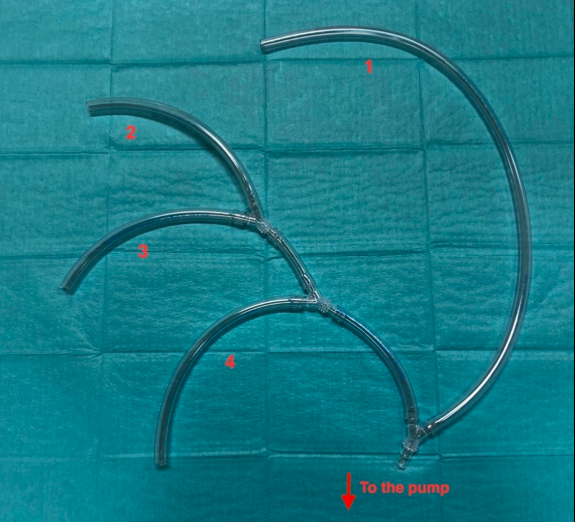Final ID: Su4191
Outcomes of a modified Frozen Elephant Trunk technique with debranch first in acute and chronic aortic arch disease
Abstract Body (Do not enter title and authors here): Introduction: Although Frozen Elephant Trunk has emerged as a valuable technique in aortic arch pathology it is still burdened by a high mortality and morbidity rate due to the technical complexity and clinical and anatomical substrates.
Research Questions: Evaluation of early hard outcomes in a surgical approach encompassing the following : 1) central cannulation of the right subclavian artery or the right axillary artery; 2) debranch-first approach (selective cannulation of left common carotid artery with single 8-mm dacron graft and the left subclavian artery for cerebral perfusion with single 10-mm dacron graft); 3) central venous cannulation of right atrium; 4) use of a home-made 4-branched perfusion circuit for extracorporeal circulation; 5) brachiocephalic artery clamping at 26–28°C and beginning of selective antegrade perfusion. The aortic arch is opened and the distal stent graft of the hybrid prosthesis is released into the descending thoracic aorta. The strengthened collar of the prosthesis is sutured to the aorta, and, after cannulation of the fourth lateral branch, systemic perfusion is resumed. The anastomosis between the hybrid prosthesis and sino-tubular junction is then completed and the cross-clamp is released. The prosthesis-elongated supra-aortic vessels are then termino-terminally re-anastomosed to the corresponding branches of the hybrid prosthesis.
Methods: Retrospective analysis of a prospectively collected database including 167 patients referred for FET (55 %acute aortic dissections, 14.5% chronic aortic dissections, and 30.5% extended aneurysms, 67% males, 9.2% diabetes mellitus, 72% arterial hypertension, 8.2% chronic renal failure, 12% peripheral vasculopathy, 3% bicuspid aortic valve, 11.9% redo)
Results: The average cardio-pulmonary bypass time, crossclamp time, cerebral and visceral perfusion time is 192, 102, 29 and 12 minutes, respectively. In-hospital mortality occurred in 16% (44% due to respiratory failure), spinal cord injury in 2.8% and stroke in 3.5% of patients.
Conclusion: Debranch-first technique and cerebral protection through the trivascular perfusion strategy appear safe and effective in the treatment of complex arch pathology.
Research Questions: Evaluation of early hard outcomes in a surgical approach encompassing the following : 1) central cannulation of the right subclavian artery or the right axillary artery; 2) debranch-first approach (selective cannulation of left common carotid artery with single 8-mm dacron graft and the left subclavian artery for cerebral perfusion with single 10-mm dacron graft); 3) central venous cannulation of right atrium; 4) use of a home-made 4-branched perfusion circuit for extracorporeal circulation; 5) brachiocephalic artery clamping at 26–28°C and beginning of selective antegrade perfusion. The aortic arch is opened and the distal stent graft of the hybrid prosthesis is released into the descending thoracic aorta. The strengthened collar of the prosthesis is sutured to the aorta, and, after cannulation of the fourth lateral branch, systemic perfusion is resumed. The anastomosis between the hybrid prosthesis and sino-tubular junction is then completed and the cross-clamp is released. The prosthesis-elongated supra-aortic vessels are then termino-terminally re-anastomosed to the corresponding branches of the hybrid prosthesis.
Methods: Retrospective analysis of a prospectively collected database including 167 patients referred for FET (55 %acute aortic dissections, 14.5% chronic aortic dissections, and 30.5% extended aneurysms, 67% males, 9.2% diabetes mellitus, 72% arterial hypertension, 8.2% chronic renal failure, 12% peripheral vasculopathy, 3% bicuspid aortic valve, 11.9% redo)
Results: The average cardio-pulmonary bypass time, crossclamp time, cerebral and visceral perfusion time is 192, 102, 29 and 12 minutes, respectively. In-hospital mortality occurred in 16% (44% due to respiratory failure), spinal cord injury in 2.8% and stroke in 3.5% of patients.
Conclusion: Debranch-first technique and cerebral protection through the trivascular perfusion strategy appear safe and effective in the treatment of complex arch pathology.
More abstracts on this topic:
Changes in Management of Acute Aortic Syndrome with Vascular Medicine Involvement in a Multidisciplinary Aortic Team
Pettinato Anthony, Milioglou Ioannis, Diggins Caroline, Krawisz Anna, Schmaier Alec, Secemsky Eric, Khabbaz Kamal, Schermerhorn Marc, Carroll Brett
Aortic Arch Calcification Improves Cardiovascular Event Risk Stratification Among Individuals With a History of Cigarette Smoke ExposureTrujillo Robert, Ansari Salman, Budoff Matthew, Mcclelland Robyn, Hansen Spencer, Szklo Moyses

